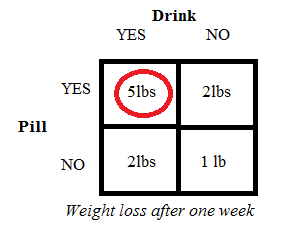Experimental Design > Interaction Effect
What is an Interaction Effect?
An interaction effect happens when one explanatory variable interacts with another explanatory variable on a response variable. This is opposed to the “main effect” which is the action of a single independent variable on the dependent variable.
For example, let’s say you were studying the effects of a diet drink and a diet pill (the explanatory variables) on weight loss. The “main effects” would be the effect of a diet drink on weight loss, and the effect of the diet pill on weight loss. The interaction effect happens when the drink and pill taken at the same time. It’s possible the combination could speed up weight loss, or even slow it down. Synergy in medicine, where two drugs work together to produce an effect greater than their additive individual effects, is a special case of an interaction effect.
The two (or more) variables that interact with each other to produce an interaction effect are called the interacting variables. If the variables don’t act upon each other at all, then we say there is no statistical interaction, or that one explanatory variable’s effect is constant across all levels of the other.
Finding Statistical Interactions
If you suspect a statistical interaction exists, a factorial design can help you identify what the interaction effects are. In a factorial design, you run every possible combination of levels (in the above example, the levels of independent variable would be the diet drink and diet pill).

The simple image above shows that you would need four variations on treatment in order to fully investigate interactions:
- Both diet pill and drink at the same time.
- Only the diet pill.
- Only the drink.
- Neither the drink nor the pill (the “control group”).
Factor analysis isn’t limited to two levels (called a two-way interaction): it can be applied to multiple levels.